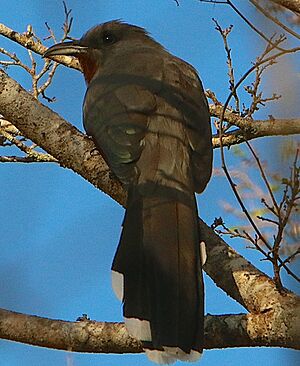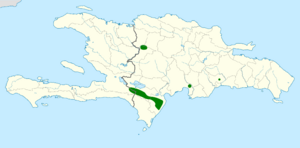Bay-breasted cuckoo facts for kids
Quick facts for kids Bay-breasted cuckoo |
|
|---|---|
 |
|
| In the Dominican Republic | |
| Conservation status | |
| Scientific classification | |
| Genus: |
Coccyzus
|
| Species: |
rufigularis
|
 |
|
| Synonyms | |
|
Hyetornis rufigularis |
|
The bay-breasted cuckoo (Coccyzus rufigularis) is a special kind of bird that belongs to the cuckoo family, called Cuculidae. It's an Endangered species, which means there aren't many left. This bird lives only in the Dominican Republic on the Caribbean island of Hispaniola. Sadly, it might have disappeared from Haiti.
Contents
About Its Name
Scientists group animals together based on how they are related. The bay-breasted cuckoo's scientific name is Coccyzus rufigularis. It used to be called by different names, but now it's part of the Coccyzus group.
People in the Dominican Republic call this bird "cúa" in Spanish. In Haitian Creole, it's known as "tako kabrit".
What It Looks Like
The bay-breasted cuckoo is about 46 to 51 centimeters (18 to 20 inches) long. About half of its length is its long tail! One male bird weighed about 128 grams (4.5 ounces).
This cuckoo has a strong, curved beak. The top part of its beak is black, and the bottom part is yellow. Both male and female birds look the same. They have gray feathers on their upper body and a gray face. Their wings have a chestnut (reddish-brown) color. Their chin and chest are a dark chestnut, and their belly is a lighter reddish-brown. The feathers under their tail are gray. Their tail is black with big white tips. Young birds look very similar to adults, but their tail feathers are a bit narrower.
Where It Lives
The bay-breasted cuckoo used to live in many places in both the Dominican Republic and Haiti. By 2020, it might have disappeared from mainland Haiti and definitely from Gonâve Island. Now, it's mainly known to nest in only two areas of the Dominican Republic.
One area is on the northern side of Sierra de Bahoruco. The other is in Nalga de Maco National Park. People have seen or photographed the bird in other places since 2005. This suggests that small groups of these birds might still live in those areas too.
This cuckoo lives in lowlands and hills, up to about 900 meters (3,000 feet) high. It can be found in different types of forests. However, it mostly prefers the areas where dry forests meet moist forests.
How It Behaves
Moving Around
The bay-breasted cuckoo does not migrate. This means it stays in the same area all year long.
What It Eats
The bay-breasted cuckoo eats many different things. Its diet includes adult insects, caterpillars, grubs, lizards, and even mice! Young cuckoos mostly eat cicadas. This bird usually looks for food from the middle of the forest trees all the way up to the very top. It moves by leaping between branches.
Making a Home
We don't know much about how the bay-breasted cuckoo breeds. Its breeding season is from February until the start of the wet season in June.
It builds a loose, flat nest made of twigs in a tree. The nest is usually placed about 3 to 6 meters (10 to 20 feet) above the ground. It likes to hide its nest in thick leaves or inside a bromeliad plant. A female cuckoo usually lays two or three eggs.
Its Calls
The most unique sound the bay-breasted cuckoo makes is a strong "cua." This sound is often followed by a fast "u-ak-u-ak-ak-ak-ak-ak-ak ak-ak." The first "cua" sound is how the bird got its local name in the Dominican Republic. It also makes sounds that are described as "bleating like a lamb." Sometimes, it makes a deep, crow-like call that sounds like "ú-wack-ú-wack-ú-wack-."
Its Future
The IUCN (International Union for Conservation of Nature) has listed the bay-breasted cuckoo as an Endangered species. This means it is at a very high risk of disappearing forever. Its population has dropped a lot since 1900. In 2020, there were only an estimated 300 to 2,900 adult birds left. Scientists believe the number is still going down.
Even though it lives in four protected areas, it is rare in all of them. The main reasons for its shrinking population are:
- Deforestation: Forests are being cut down for farming and to make charcoal.
- Habitat damage: Animals grazing (eating plants) can harm its home.
- Hunting: Some people hunt these birds.
- Chemicals: Farm chemicals might also be a problem.
Climate change is expected to affect the moisture in these areas. This could lead to more natural and human-caused fires in the future. To help this bird, a full survey is needed to find out exactly where it lives and how many there are.


